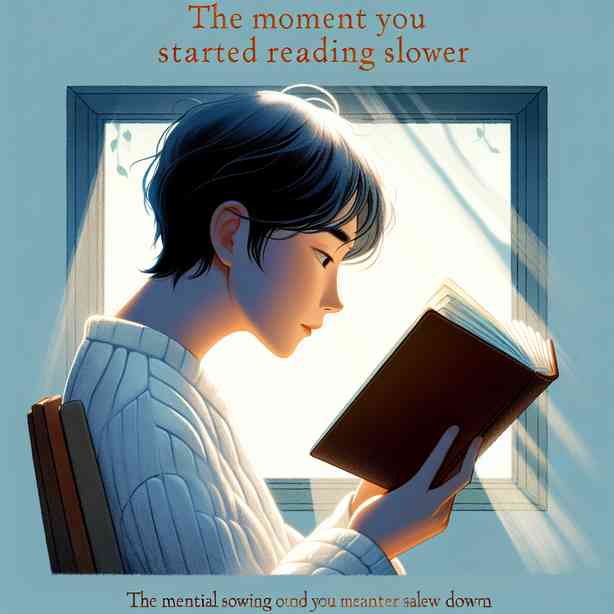
The experience of reading is often seen as a straightforward task, one that seems to come naturally to most people. However, there comes a moment in everyone’s reading journey when they begin to notice a shift in their reading speed. This moment—marked by the realization that we are reading slower—can be profound and sometimes even disconcerting. Understanding this phenomenon not only sheds light on our cognitive processes but also allows us to appreciate the evolution of our reading skills.
Initially, your reading speed is often determined by early exposure to texts during childhood. As you learn to decode letters and form words, the act of reading transforms from a laborious task into a fluid experience. Yet, as you grow older, this fluidity can sometimes diminish. The moment you start reading slower can serve as a signal that your relationship with text is evolving. It may be due to a variety of factors, such as increased comprehension, the complexity of the material, or even a change in your cognitive preferences.
This slowdown might be a result of the types of texts you engage with. For instance, academic or technical materials often require a more deliberate pace as you attempt to grasp intricate concepts or nuanced arguments. Slowing down allows you the time to digest information, to ponder the implications of what you’re reading, and to synthesize knowledge across different disciplines. In this sense, reading slower can be a tool for deeper understanding, transforming reading into an active rather than passive endeavor.
Additionally, this change in reading speed can reflect your shifting priorities. Life experiences can alter not only what you read but how you read. Perhaps you are seeking out more challenging literature, or you might simply be in a phase of life where your emphasis is on quality over quantity. This thoughtful approach encourages you to savor the text, to analyze characters in fiction or to contemplate arguments in non-fiction, enriching your overall experience. Thus, the moment you notice yourself reading more deliberately is a sign of growth, an indication that you’re prioritizing your learning and comprehension.
Moreover, the digital age has ushered in a profound transformation in our reading habits. With smartphones, tablets, and computers, we are bombarded with a plethora of information at our fingertips. This constant stream can lead to skimming and scanning rather than deep reading. In this context, noticing your slower reading speed could be a response to the overwhelming nature of digital content. It might encourage you to engage more thoughtfully with the material, resisting the temptation to rush through. In this way, the moment of slowing down can be perceived as a reclamation of our reading practices, allowing us to disconnect from the noise and focus on meaningful engagement with texts.
As we reflect on the implications of reading slower, it’s valuable to acknowledge the potential benefits of this experience. Taking the time to read at a slower pace fosters critical thinking. When you read slowly, you have the opportunity to question the author’s intent, analyze the writing style, and explore the context of the work. Engaging in these practices transforms reading from a mere consumption of information into an enriching dialogue between the reader and the text. In a way, slowing down can make you a more discerning reader, one who approaches texts with curiosity and insight.
Equally important is recognizing that reading speed is not a definitive measure of comprehension or intelligence. In fact, some of the greatest insights come not from racing through pages but rather from taking the time to reflect. This is particularly relevant in educational settings where the pressure to perform quickly can overshadow the importance of understanding. Teachers and students alike benefit from embracing the notion that slowing down can lead to breakthroughs in comprehension and retention of information.
In addition to the cognitive benefits, there’s a personal dimension to the experience of reading slower. Many readers find that this shift allows for a more mindful approach, encouraging them to connect with the material on an emotional level. Literature, for example, often invites us to move beyond the surface, pushing us to resonate with themes and characters that mirror our own experiences. Slowing down can transform reading into a profoundly personal journey, where the act of engaging with the text becomes a source of comfort, healing, and reflection.
Ultimately, the moment you start reading slower can represent a powerful inflection point in your life as a reader. It encourages exploration, introspection, and the courage to revisit the texts you once flew through. Rather than viewing this change as a setback or limitation, embrace it as an opportunity to deepen your engagement with literature and knowledge. Every book you read becomes an invitation to discover new ideas, and slowing down enriches that journey.
As you continue on this journey of evolving reading habits, consider implementing practices that support and enhance your experience. Setting aside dedicated reading time can significantly impact your reading pace. Find a quiet space where you can immerse yourself in a book without distractions, allowing you to savor each word. Experiment with varying genres and formats, from poetry to essay collections, exploring how each influences your reading speed and understanding.
In conclusion, recognizing the moment when you start reading slower is not merely about a change in speed but rather a burgeoning awareness of your relationship with the written word. It signifies growth, introspection, and a deeper commitment to comprehending and appreciating literature. Embrace this evolution with open arms, knowing that the journey of reading is as rich and rewarding as the knowledge you gain from each page. In doing so, you’ll cultivate a lifelong love for literature, characterized not by speed but by a profound appreciation for the beauty of language and the power of stories.


